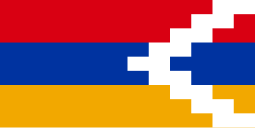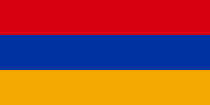Flag of the Republic of Artsakh
 | |
| Use | National flag |
|---|---|
| Proportion | 1:2 |
| Adopted | June 2, 1992 |
| Design | A horizontal tricolor of red, blue, and orange with a white sideways zig-zag chevron in the fly |
 Flag of Armenia | |
| Use | Historical |
| Proportion | 1:2 |
| Adopted | September 2, 1991 |
| Design | A horizontal tricolour of red, blue, and orange |
 Since the Nagorno-Karabakh Autonomous Oblast lacked a flag, the Flag of Azerbaijan SSR was used. | |
| Use | Historical |
| Proportion | 1:2 |
| Design | see Flag of the Azerbaijan Soviet Socialist Republic |
 Flag of the Kingdom of Artsakh (1000–1261) | |
| Use | Historical |
| Proportion | 1:2 |
| Part of a series on the |
| Culture of Artsakh |
|---|
 |
| History |
| People |
| Languages |
| Religion |
| Music |
| Sport |
On June 2, 1992, the self-proclaimed Republic of Artsakh, a de facto independent republic internationally recognized as part of Azerbaijan, in the South Caucasus region, adopted a flag derived from the flag of Armenia, with only a white pattern added. A white, five-toothed, stepped pattern was added to the flag, beginning at the two verges of the flag's right side and meeting at a point equal to one-third of the distance from that side.[1] The white pattern symbolizes the current separation of Artsakh from Armenia proper and its aspiration for eventual union with "the Motherland."[2] This symbolizes the Armenian heritage, culture and population of the area, and represents Artsakh as a separated region of Armenia by the triangular shape and the zigzag cutting through the flag. The white pattern on the flag is also similar to the designs used on rugs, a symbol of national identity.[3] The ratio of the flag's breadth to its length is 1:2, same as the Armenian Tricolor.[1]
See also
References
- ^ a b "Attributes of Statehood". Ministry of Foreign Affairs of Nagorno-Karabakh. Archived from the original on December 16, 2006. Retrieved 2007-01-09.
- ^ "Flag of Artsakh / Nagorno-Karabakh". Flags of the World. Retrieved 2007-01-09.
- ^ "The Significance of the Armenian Rug | Armenian News By MassisPost". massispost.com. Retrieved 2015-12-01.

